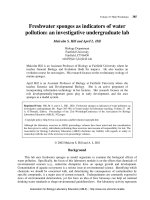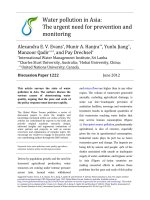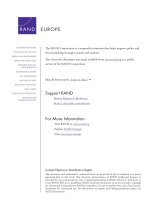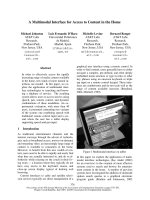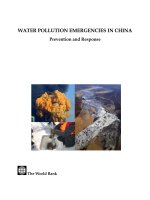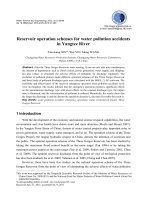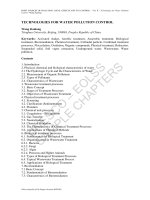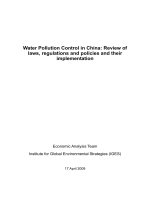Reservoir operation schemes for water pollution accidents in Yangtze River pdf
Bạn đang xem bản rút gọn của tài liệu. Xem và tải ngay bản đầy đủ của tài liệu tại đây (1.2 MB, 8 trang )
Water Science and Engineering, 2012, 5(1): 59-66
doi:10.3882/j.issn.1674-2370.2012.01.006
e-mail:
—————————————
This work was supported by the Nonprofit Scientific Research Project of the Ministry of Water Resources of
China (Grant No. 20081035) and the National Fund for Major Projects of Water Pollution Control (Grant No.
2009ZX07104-006).
*Corresponding author (e-mail:
)
Received Apr. 27, 2011; accepted Oct. 9, 2011
Reservoir operation schemes for water pollution accidents
in Yangtze River
Xiao-kang XIN*, Wei YIN, Meng WANG
Changjiang Water Resources Protection Institute, Changjiang Water Resources Commission,
Wuhan 430051, P. R. China
Abstract: After the Three Gorges Reservoir starts running, it can not only take into consideration
the interest of departments such as flood control, power generation, water supply, and shipping,
but also reduce or eliminate the adverse effects of pollutants by discharge regulation. The
evolution of pollutant plumes under different operation schemes of the Three Gorges Reservoir
and three kinds of pollutant discharge types were calculated with the MIKE 21 AD software. The
feasibility and effectiveness of the reservoir emergency operation when pollution accidents occur
were investigated. The results indicate that the emergency operation produces significant effects
on the instantaneous discharge type with lesser effects on the constant discharge type, the impact
time is shortened, and the concentration of pollutant is reduced. Meanwhile, the results show that
the larger the discharge is and the shorter the operation duration is, the more favorable the result is.
Key words: water pollution accident; emergency operation; water environment model; Three
Gorges Reservoir
1 Introduction
With the development of the economy and natural science research capabilities, the water
environment and river health have drawn more and more attention (Moyle and Mount 2007).
In the Yangtze River Basin of China, dozens of water control projects play important roles in
power generation, water supply, water transport, and so on. The operation scheme of the Three
Gorges Project, the largest hydraulic project in China, attracts the attention of scientists and
the public. The optimal operation scheme of the Three Gorges Reservoir has been studied by
taking the maximum flood control benefit as the main target (Tan 1996) or by taking the
maximum power output as the main target (Yao et al. 2009; Soares and Carneiro 2001; Chen
et al. 2009). The optimal reservoir discharge from the point of view of ecological protection
has also been studied (Xu et al. 2009; Vehanen et al. 2005; Cheng and Chen 2007).
However, there have been few studies on the optimal operation scheme of the Three
Gorges Reservoir from the point of view of eliminating the adverse effects of water pollution
Xiao-kang XIN et al. Water Science and Engineering, Mar. 2012, Vol. 5, No. 1, 59-66
60
accidents. Fu et al. (2008) used a numerical model to study the pollution spill in the Songhua
River, but they did not address methods to eliminate the adverse effects. Samuel and Bahadur
(2006) developed an integrated water quality security system for emergency response, and
suggested using a water regulation method to dilute the pollutants. Kuang et al. (2010)
established a two-dimensional hydrodynamic and pollution transport model to study the
influences of three different discharges from the Taipu Gate and proposed an optimal water
regulation scheme. This study took advantage of a two-dimensional mathematical water
environment model and carried out some research on the emergency operation of the Three
Gorges Reservoir when water pollution accidents occurred at the Yichang section of the
Yangtze River.
2 Two-dimensional water environment model
2.1 Control equations
The water environment model is composed of the hydrodynamic model and the
advection-dispersion model. The control equations can be written as
c
uv
S
xy
∂∂
+=
∂∂
(1)
()
2
a
t
00
1
d
u
z
vu
p
uu g u
fv g z F
tx y x x x z z
ζ
ζρ
υ
ρρ
∂
∂
∂∂ ∂ ∂ ∂ ∂
++ =− − − ++
∂∂ ∂ ∂ ∂ ∂ ∂ ∂
(2)
()
2
a
t
00
1
d
v
z
uv
p
vv g v
fu g z F
txy y y y zz
ζ
ζρ
υ
ρρ
∂
∂
∂∂∂ ∂∂∂
++=−− − ++
∂∂ ∂ ∂ ∂ ∂ ∂∂
(3)
22
22
xy
CCC C C
uvD D KC
txy x y
∂∂∂ ∂ ∂
++= + −
∂∂∂ ∂ ∂
(4)
Eq. (1) is the continuity equation, Eqs. (2) and (3) are the momentum equations in the
x and y
directions, respectively, and Eq. (4) is the advection-dispersion equation. In the equations,
u
and
v are the velocities and
u
F and
v
F are the resistances in the x and y directions,
respectively;
c
S is the source term; g is the acceleration of gravity;
a
p is the pressure on the
cross-section;
t is time;
ζ
is the water level;
f
is the coefficient of Coriolis force;
0
ρ
is
the water density;
t
υ
is the water dispersion coefficient; C is the pollutant concentration; and
x
D
and
y
D
are the transverse and longitudinal diffusion coefficients, respectively.
These partial differential equations cannot be analytically solved, and a lot of
mathematical solution methods have been developed, such as the finite difference method
(Xing and Shu 2005), finite volume method (Begnudelli and Sanders 2006), finite element
method (Yu et al. 2004), and finite analytic method. We take advantage of the simulation
software MIKE 21 AD, which was developed by the Demark Hydraulic Institute with the
finite volume method (Euler schedule), to solve these equations. It must be pointed out
that the Courant number should be less than 1.0 in order to ensure the stability of the model
(DHI 2005).
Xiao-kang XIN et al. Water Science and Engineering, Mar. 2012, Vol. 5, No. 1, 59-66
61
2.2 Model mesh and parameters
The study area is an 80 km-long river section of the Yangtze River between Yichang City
and Zhijiang City, named the Yichang section, and shown in Fig. 1. It was meshed with
quadrilateral and triangular grid cells, where the maximum size of the quadrilateral grid cells
was about 200 m
× 200 m, and the maximum area of the triangular grid cells was about 5 000 m
2
.
The mesh of the Yichang section is shown in Fig. 2.
Fig. 1 Sketch of Yichang section of Yangtze River
Fig. 2 Sketch of model mesh of Yichang section of Yangtze River
The bathymetric data measured in 2007 were used to interpolate the elevation
information to the mesh shown above. The data of the upstream boundary condition were from
the Yichang gauging station and the data of the downstream boundary condition were from the
Xiao-kang XIN et al. Water Science and Engineering, Mar. 2012, Vol. 5, No. 1, 59-66
62
Changmenxi gauging station. Taking the worst condition into account, the discharge of the
upstream boundary was 5 300 m
3
/s, and the corresponding water level of the downstream
boundary was 33.62 m.
The main parameters of the hydrodynamic model are Manning’s coefficient and the eddy
viscosity coefficient (Smagorinsky constant). The value of Manning’s coefficient used in the
case study was 0.031 and the eddy viscosity was 0.28. The calibration of the model using the
field data at Zhicheng Station shows that the calculated velocity was about 0.85 m/s and the
monitoring velocity was about 0.92
m/s, which indicates that the precision of this
hydrodynamic model was acceptable and it could be used in the case study.
3 Conditions of calculation cases
As the monitoring data of water pollution are insufficient, the pollution accidents were
simplified as leakage quantities and leakage time of permanganate index (COD
Mn
). Most
attention was paid to the accidents occurring at Yiling and Xiaoting districts. The calculation
start time was 2009-02-01T00:00:00 and the end time was 2009-02-02T23:53:20, and the
pollution accident was imagined to have occurred at 2009-02-01T02:00:00. At that time, the
Three Gorges Cascade Dispatching Center received emergency operation instructions, and the
water discharged for regulation reached the Yichang cross-section at 2009-02-01T02:30:00.
Here, the effects of river section between the Three Gorges Dam and Gezhou Dam were ignored.
It is assumed that there were three leakage modes of the pollutant: (1) the pollutant with a
total amount of 180 t leaked into the Yangtze River channel center within 30 min (CCST); (2)
the pollutant with a total amount of 18 t leaked from the bank side within 3 min (BST); and (3)
the pollutant leaked from the bank side constantly with a rate of 10 kg/s (BCL).
There were five operation cases at the Yichang cross-section for each leakage type: (1)
the operational discharge was 5
300 m
3
/s and lasted 1 h (contrast case); (2) the operational
discharge was 15
900 m
3
/s and lasted 1 h (case 1); (3) the operational discharge was
15
900 m
3
/s and lasted 2 h (case 2); (4) the operational discharge was 15 900 m
3
/s and lasted 3 h
(case 3); and (5) the operational discharge was 26
500 m
3
/s and lasted 1 h (case 4). In summary,
the conditions of the calculation cases are shown in Table 1.
4 Results and discussion
4.1 Water velocity
Based on the results of calculated velocities of the operation cases using the
hydrodynamic model, we extracted the point velocities at the Yiling and Xiaoting
cross-sections (Fig. 3). As we can see, the velocities at these two sections increased
significantly when the Three Gorges Reservoir started emergency operation, indicating that
the reservoir emergency operation facilitated the convection and dispersion of the pollutant.
Meanwhile, the effects of reservoir operation on the Xiaoting cross-section were delayed and
Xiao-kang XIN et al. Water Science and Engineering, Mar. 2012, Vol. 5, No. 1, 59-66
63
Fig. 3 Sketch of velocity profiles at Yiling and Xiaoting cross-sections
decayed. The reason is that the Xiaoting cross-section is 17 km downstream of the Yiling
cross-section: within this distance, the instantaneous discharge was cut by channel storage and
the conveyance time was lengthened.
The largest increment degrees of velocities for each calculation cases are listed in Table 2.
As can be seen, the velocity increment of operation case 4 is the largest due to the largest
instantaneous discharge, while those of the other three operation cases are almost the same.
Table 2 Velocity increment degree for each case
Operation
case
Yiling cross-section Xiaoting cross-section
Contrast velocity
(m/s)
Operation velocity
(m/s)
Increment degree
(%)
Contrast velocity
(m/s)
Operation velocity
(m/s)
Increment degree
(%)
Case 1 0.9 2.3 155 0.65 1.23 89
Case 2 0.9 2.3 155 0.65 1.24 91
Case 3 0.9 2.3 155 0.65 1.24 91
Case 4 0.9 3.5 289 0.65 1.69 160
4.2 Increase of water volume
The main method of reservoir emergency operation to eliminate the adverse effects of
sudden water pollution is to increase the discharge, because a large discharge is good for
pollutant advection and dispersion. However, a large discharge may produce a large volume of
water, which produces adverse effects on power generation or water supply. Therefore, the
increment of water volume is an important indicator for optimizing the operation scheme.
Based on the calculated results, the increment data of water volume are listed in Table 3. We
can see from Table 3 that the increment of water volume of operation case 3 is the largest,
since its operation duration is the longest, and case 2 and case 4 are the second largest while
case 1 is the smallest.
Xiao-kang XIN et al. Water Science and Engineering, Mar. 2012, Vol. 5, No. 1, 59-66
64
Table 3 Increment of water volume from Three Gorges Reservoir under different cases 10
4
m
3
Operation case Contrast water volume Operational water volume Increment
Case 1 1 908 5 724 3 816
Case 2 3 816 11 448 7 632
Case 3 5 724 17 172 11 448
Case 4 1 908 9 540 7 632
4.3 Pollutant concentration evolution
The evolution of the pollutant concentration can be obtained from the results of the
environment model, and it can reflect the pollution plume’s position at different times. Taking
the first leakage type (CCST) as an example, the sketches of the contrast case, case 2, and
case 4 are shown in Fig. 4. Fig. 4 shows that the pollution plume’s position of case 4 is furthest
while that of the contrast case is nearest after the emergency operation lasts 28 min, and that
the high-concentration (larger than 0.01 kg/m
3
) polluted water mass has disappeared after the
emergency operation lasts 6 h and 28 min for case 4, which demonstrates that the larger the
discharge is, the shorter the pollution duration is. The characteristic numbers for each case are
listed in Table 4. If the pollution accident happened at the Yiling cross-section, as it can be
seen from the table, the cases with larger discharge spent less time in eliminating the
high-concentration plume and reducing the impact scope accordingly. And similar results can
be obtained in the case of pollution accidents occurring at the Xiaoting cross-section.
Table 4 Impact time and scope of pollutant under different cases
Operation case
Yiling cross-section Xiaoting cross-section
Impact time (h) Pollution scope (km) Impact time (h) Pollution scope (km)
Contrast case 13.37 34.2 11.57 21.8
Case 1 10.97 31.9 9.97 22.7
Case 2 8.10 30.3 8.60 25.2
Case 3 6.43 29.1 7.63 26.1
Case 4 6.47 27.1 8.43 25.2
5 Conclusions
This study shows that water control projects not only supply power and fresh water, but
also play positive roles in mitigating the adverse effects of sudden water pollution
accidents under optimal operation schemes. From this study, three important conclusions can
be drawn:
(1) Reservoir emergency operation can shorten the pollution duration and scope
significantly. Taking case 3 as an example, the pollution duration is shortened by 7 h, and the
pollution scope is shortened by 5 km.
(2) With regard to the discharge increment and pollution mitigation effects, case 4 is
better than cases 3, 2, and 1, which indicates that the larger the instantaneous discharge is, the
Xiao-kang XIN et al. Water Science and Engineering, Mar. 2012, Vol. 5, No. 1, 59-66
65
Fig. 4 Profiles of pollutant concentration under different reservoir operation schemes
better the effect is.
(3) As the Xiaoting cross-section is 17 km downstream of the Yiling cross-section, and
the water discharged for regulation needs time to reach the accident location, the pollution
duration is comparably long, while the pollution scope is shortened.
Meanwhile, since this is preliminary research, a few improvements should be made in
further studies:
(1) The computation model simplified the water transport in the section between the
Three Gorges Dam and Gezhou Dam, which may cause significant error. A model taking the
dam, gate, and water channel into account together should be developed in future research.
Xiao-kang XIN et al. Water Science and Engineering, Mar. 2012, Vol. 5, No. 1, 59-66
66
(2) Although 12 cases have been studied here, they are insufficient to describe the
pollution accidents because of their uncertainty.
(3) Since the emergency monitoring data are insufficient, the validation of model
is inadequate.
References
Begnudelli, L., and Sanders, B. F. 2006. Unstructured grid finite-volume algorithm for shallow-water flow and
scalar transport with wetting and drying. Journal of Hydraulic Engineering, 132(4), 371-384.
[doi:10.1061/(ASCE)0733-9429(2006)132:4(371)]
Chen, J. H., Guo, S. L., Liu, P., and Liu, X. Y. 2009. Joint operation benefit analysis of five reservoirs of Three
Gorges and Qingjiang Cascade Reservoirs. Water Power, 35(1), 92-95. (in Chinese) [doi:0559-
9342(2009) 01-0092-04]
Cheng, G. W., and Chen, G. R. 2007. Ecological operating experiment for Three-Gorge Reservoir, creating
healthy stream environment for Changjiang River. Journal of Hydraulic Engineering, 38(s1), 526-530.
(in Chinese)
Demark Hydraulic Institute (DHI). 2005. MIKE 21 and MIKE3 Flow Model FM: Hydrodynamic and
Transport Module Scientific Documentation. Hørsholm: Demark Hydraulic Institute.
Fu, W. J., Fu, H. J., Scott, K., and Yang, M. 2008. Modeling the spill in the Songhua River after the explosion
in the petrochemical plant in Jilin. Environmental Science and Pollution Research, 15(3), 178-181.
[doi:10.1065/espr2007.11.457]
Kuang, C. P., Xing, F., Liu, S. G., Lou, X., He, L. L., and Deng, L. 2010. Numerical simulation and analysis of
emergency measurements for water pollution accident in Huangpujiang River. Yangtze River, 41(7),
43-47. (in Chinese)
Moyle, P. B., and Mount, J. F. 2007. Homogenous rivers, homogenous faunas. Proceedings of the National
Academy of Science of United States of America, 104(14), 5711-5712. [doi:10.1073/pnas.0.01457104]
Samuel, W. B., and Bahadur, R. 2006. An Integrated Water Quality Security System for Emergency Response:
Security of Water Supply System: From Source to Tap. Netherlands: Springer. [doi:10.1007/1-
4020-4564_9]
Soares, S., and Carneiro, A. A. F. M. 2001. Optimal operation of reservoirs for electric generation. IEEE
Transactions on Power Delivery, 6(3), 1101-1107. [doi:10.1109/61.85854]
Tan, P. L. 1996. Real-time optimal operation models for the Three-Gorge-Reservoir-Centered Yangtze River
flood control system. Advances in Water Science, 7(4), 331-335. (in Chinese)
Vehanen, T., Jurvelius, J., and Lahti, M. 2005. Habitat utilization by fish community in a short-term regulated
river reservoir. Hydrobiologia, 545(1), 257-270. [doi:10.1007/s10750-005-3318-z]
Xing, Y. L., and Shu, C. W. 2005. High order finite difference WENO schemes with the exact conservation
property for the shallow water equations. Journal of Computational Physics, 208(1), 206-227.
[doi:10.1016/ j.jcp.2005.02.006]
Xu, K., Zhou, J. Z., Gu, R., and Qin, H. 2009. The effect of different reservoir operating on biological
resource in the basin. Journal of Hydroecology, 2(2), 134-138. (in Chinese)
Yao, Y. T., Zhang, H., and Meng, Q. S. 2009. Research on optimal operation scheme of Three Gorges cascade
reservoirs based on greatest power. The 2009 Symposium of China Hydropower Engineering Society,
Information Special Committee, 243-249. Beijing: China Society for Hydropower Engineering. (in
Chinese)
Yu, X. M., Wang, C., Deng, X. H., and Zhang, X. B. 2004. Research on branch stream flow and sediment
mathematical model. Journal of Shihezi University (Natural Science), 22(3), 221-224. (in Chinese)
